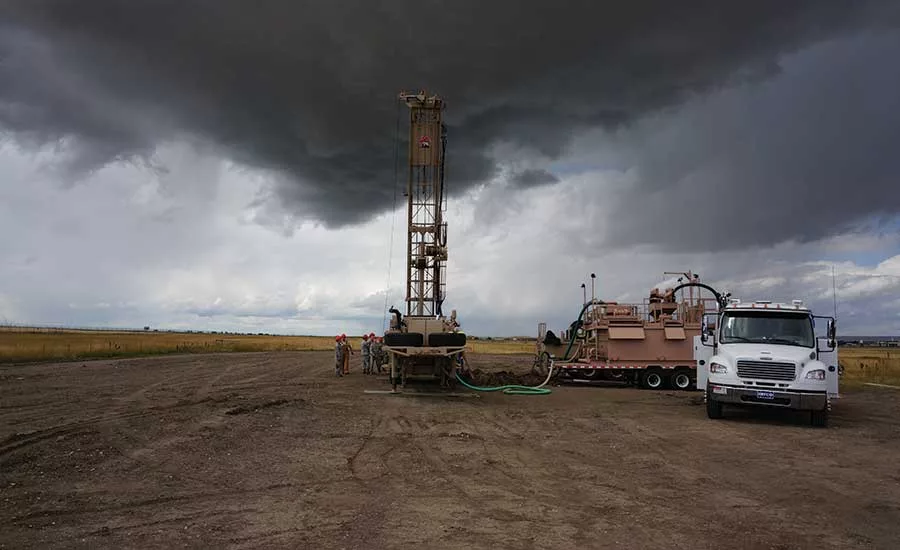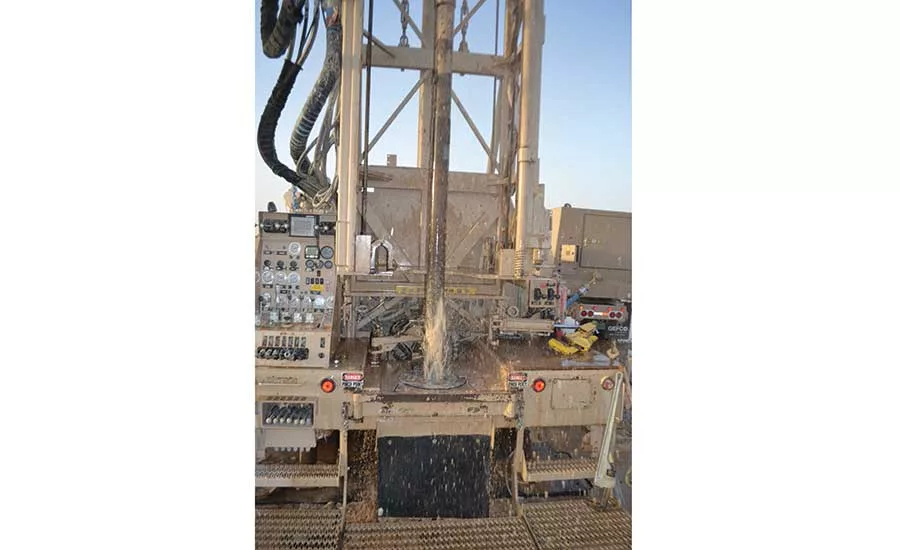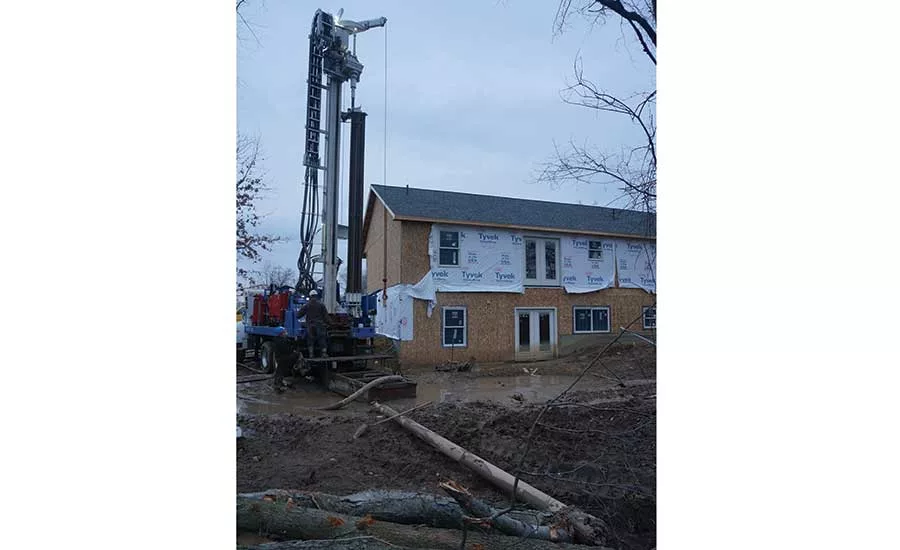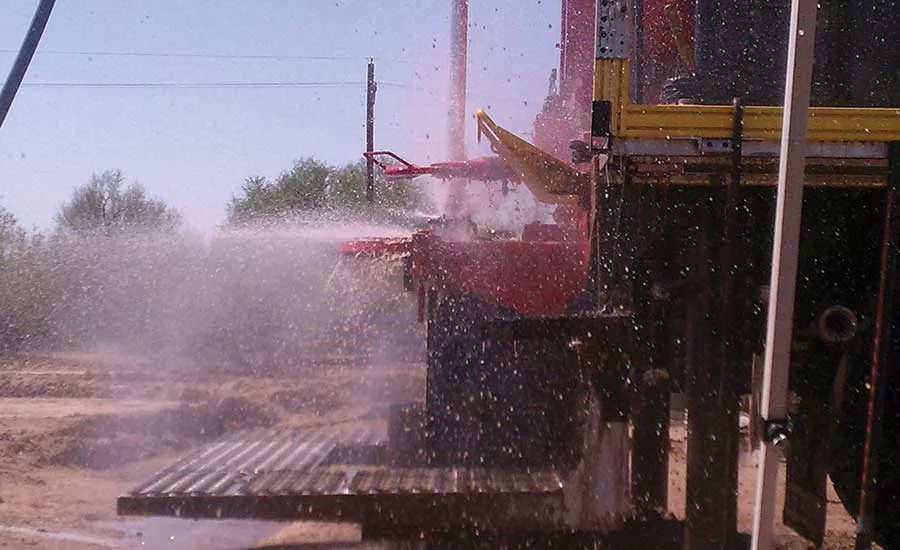Well Development for Basic Rotary Drilling

For even the best drillers, getting the hole drilled doesn’t do you any good if you can’t get adequate water out of it. That’s where development comes in. Source: Brock Yordy photo



Air development could improve by creating tools that could focus compressor energy into 2- to 3-foot sections of the production zone. Source: Brock Yordy
There is nothing more rewarding than making water flow out of the ground. Water is a necessary component of life and, as water well drillers, we get to help sustain life with every water well installed. A successful water well is achieved by choosing the proper drilling method. It is easy to make a hole in the ground. It takes planning and proper procedures to make water come out of it. Let us assume we have the hole in the ground, casing, screen and gravel pack set. The annulus was properly sealed to state standards. Now it is time to develop the well. Using the mud rotary method, what causes a production zone not to pump water? In past experiences, I have used the following factors to determine why a production zone produces less than expected.
In drilling, when a well produces less than expected we chalk it up to being “the well from hell” or “mother nature won this battle.” These factors help me remove superstition and look at the hard facts.
Hole Cleaning
Drill solids can negatively impact a production zone by plugging pore spaces that would have allowed water into the wellbore. The uphole velocity to effectively clean a borehole has to be at a rate faster than the detrition of a newly created drill solid. During our drilling phase, our goal is to remove the largest cutting possible. Drill solids require a minimum uphole velocity of 60 feet per minute for mud rotary. A 1-inch drill solid traveling at 60 feet per minute requires a drilling fluid’s uphole velocity to be greater than 100 feet per minute.
Think of that 1-inch solid like the space shuttle attempting to leave Earth’s gravity. The energy and speed have to be stronger than gravity to leave Earth intact. The goal is to keep the solids intact from creation to surface. When solids break down in the hole, the fluid properties break down, allowing the fluid to invade the formation, destabilizing the borehole and forcing drill solids out into the formations. To be successful, you must have adequate uphole velocity to clean the borehole. The solids left downhole prevent a well from producing at full capacity.
Drilling Fluid Program and Properties
The right drilling fluids program is required to have proper uphole velocity and hole cleaning. A drilling fluid’s viscosity will directly impact uphole velocity. As a young mud guy for Baroid IDP, the mantra was “viscosity is the resistance to flow,” and that resistance prevents proper hole cleaning. An excellent drilling fluid package will have minimal impact on the borehole and production zone. To combat changing geological formations, the drilling fluid program will include sodium bentonite drilling gel, filtration control additives, clay inhibitors, surfactants and loss circulation material.
Water chemistry and mixing requirements can directly impact the effectiveness of that program. Unyielded bentonite and un-sheared polymers have a greater impact on aquifer production than native solids. The problem starts with mixing drill fluids in the same pit that is pumping fluid downhole while drilling. The materials do not have adequate time to mix, shear and yield out. The unyielded material is pumped downhole and out into the production zone. Then that material continues to hydrate and embed itself in the water bearing zone.
Maintaining proper drilling fluid properties can be a tricky balancing act between drilling and mixing. A premix tank can remove the balancing act, allowing you to continue drilling while maintaining your drilling fluid. A well-maintained drilling fluid for a water well will have the following: a mud weight less than 8.8 pounds per gallon, sand content below 1 percent, and a filtrate of 15 milliliters or less. The goal is to build a stable borehole with a thin filter cake that can be removed during development.
Well Development Steps
Well development is a two to three step method of removing solids and opening up the water production zone. The first part breaks down the filter cake and re-opens up the porosity of the water-bearing zone using agitation. The second step is the act of pumping or surging water in and out of the production zone. The pumping out phase will pump fine native solids out of the well and help increase the ability for water to flow through the production area.
When I was a young driller in west Michigan, during well development, my father would always smile and say, “The longer a sand and gravel aquifer takes to clear up, the longer the life of the well.” That has stuck with me on water well projects all over the world; he is right regardless of the well completion method. If the method chosen can remove filter cake, undesirable solids and native formation solids holding back the water’s ability to flow into the well, then you will be successful. That is why we call it “development” — to develop all the undesirable blockers from our production zone.
All drilling methods are disruptive to production zones. Once a bit penetrates the water-bearing formation, solids will invade that formation. A third step can be utilized by pumping at high pressure a development fluid into the formation. This fluid can be as simplistic as a pH-adjusted chlorinated water or a complex combination of acids, dispersant and other chemicals designed to help break down the filter cake and natural clays that were forced into the production zone. To work properly, these fluids require lots of energy through agitation to deteriorate natural and commercial clays. Consult with your local drilling fluids representative to learn the proper manufacturer recommend volumes and introduction method. The three-step method can increase production and decrease development time. The key is to utilize a tool that can focus the hydraulic energy out into the plugged production zone.
Our progress in drilling technology to drill and install all the necessary components to create a well has significantly advanced since the days of cable tool. However, I believe that our progress has regressed when it comes to methods of well development. In cable tool we utilized surge blocks, pumping off tools and bailers to agitate and force the breakdown of solids and develop the production zone. Then rig technology progressed and rotary rigs no longer needed walking beams to drive casing, bail out the borehole and develop the well.
We replaced that method with developmental air and large-capacity air compressors. Air development allows us to develop the production zone either by forcing air into the area or by pumping water up the borehole. We can increase the capabilities of air development by creating tools that focus the compressor energy into 2- to 3-foot sections of the production zone versus an open-end drill rod at the bottom or top of the production zone. Consider that air development will not have the vacuum or hydraulic energy that a surge block would have. Air development requires focused energy to push through the screen, gravel pack and filter cake to clear a pathway for water to flow. The goal for any development method is to focus the development energy into the least productive section of the production zone. Often, once a low production zone has opened up, the rest of the area will develop quickly.
Regardless of the drilling method or development method used to complete a well, it is important to consider how much impact we have on the water production zone. It is good practice to size your bit according to the required casing size. (Always follow state and local regulations in regards to minimum hole size.) The hole diameter and casing diameter can affect your development capabilities and time needed. The larger the borehole, the further away the filter cake is from the screen and the more energy it will take to break down solids on the outside of the borehole. Compound that with poor drilling fluid properties, and you could have a filter cake 1 inch thick and nearly impossible to break down in a couple of hours of development. If you have time, you can fix almost any production zone issues. The best results in correcting a plugged off production area come from repeating the three-step method. Aquifers develop faster by agitating and then allowing time to rest. The rest period helps remove more undesirable solids by enabling the solids to come to rest in larger pore spaces.
Development is the final step in completing a well, but actual production capacity is directly relative to the amount of available water in the ground. We do not have control over where man builds his civilization. It is a given that there will be places on earth that we will not be able to find water. Remember: As drillers, our job is to find water with the minimal amount of impact as possible, not to walk on water.
Looking for a reprint of this article?
From high-res PDFs to custom plaques, order your copy today!









